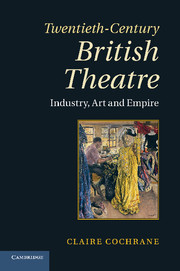Book contents
- Frontmatter
- Contents
- Acknowledgements
- Introduction
- Chapter 1 The topography of theatre in 1900
- Chapter 2 Structures of management
- Chapter 3 The profession of acting
- Chapter 4 The amateur phenomenon
- Chapter 5 The topography of theatre in 1950
- Chapter 6 The business of theatre
- Chapter 7 The changing demographic of performance
- Chapter 8 The topography of theatre in 2000
- Conclusion
- Notes
- Select Bibliography
- Index
Chapter 1 - The topography of theatre in 1900
Published online by Cambridge University Press: 05 November 2011
- Frontmatter
- Contents
- Acknowledgements
- Introduction
- Chapter 1 The topography of theatre in 1900
- Chapter 2 Structures of management
- Chapter 3 The profession of acting
- Chapter 4 The amateur phenomenon
- Chapter 5 The topography of theatre in 1950
- Chapter 6 The business of theatre
- Chapter 7 The changing demographic of performance
- Chapter 8 The topography of theatre in 2000
- Conclusion
- Notes
- Select Bibliography
- Index
Summary
In order to delineate the principle features of theatre across the British Isles at the start of the twentieth century, it is important to be aware of the effects of stratification. Evidence of cultural practice in the case of buildings, for example, is literally embedded in different layers in the landscape. The form and structure of each building, its relationship spatially and conceptually to other built structures, is the product of human agency and a particular moment in time and, indeed, the convergence of other, past and often disruptive moments. That built landscape comes at the end of another more complex process where the elements of physical stratification in the natural environment become the source of social and economic formations.
This book explores theatre practice as a component in a whole matrix of social and economic activity, and thus this chapter focuses first on how theatre functioned in a wider industrial context in 1900 and the origins of that context. Because theatre is peculiarly dependent on performative interactions in space and the relationship of diverse groups of human agents in those spaces, it is also necessary to consider not only the materiality of spatial relations, but also the consequences of abstract notions of space. Thus the specificities of social space become part of the topography as well as larger abstract or imagined spatial frameworks. Nation and empire can be physically delineated and measured – flags are flown and borders agreed or imposed – and there are physical, especially, demographic, consequences. But the psychological impact of what Henri Lefebvre conceptualises as ‘abstract space’ or the ‘dominant form of space’, which I will call ‘the space of power’, is of particular interest to the theatre historian as she records the way creative and expressive cultural ‘need’ has been mediated or restrained within a political framework.
- Type
- Chapter
- Information
- Twentieth-Century British TheatreIndustry, Art and Empire, pp. 17 - 45Publisher: Cambridge University PressPrint publication year: 2011



